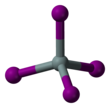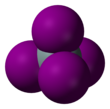 | |||
|
| |||
 | |||
| Names | |||
|---|---|---|---|
| Other names
silicon tetraiodide Tetraiodosilane | |||
| Identifiers | |||
| CAS Number | |||
| 3D model (JSmol) | |||
| ChemSpider | |||
| ECHA InfoCard | 100.033.355 | ||
| EC Number |
| ||
| PubChem CID | |||
| CompTox Dashboard (EPA) | |||
InChI
| |||
SMILES
| |||
| Properties | |||
| Chemical formula | SiI4 | ||
| Molar mass | 535.7034 g/mol | ||
| Appearance | white powder | ||
| Density | 4.198 g/cm | ||
| Melting point | 120.5 °C (248.9 °F; 393.6 K) | ||
| Boiling point | 287.4 °C (549.3 °F; 560.5 K) | ||
| Solubility in water | reacts | ||
| Solubility in organic solvents | soluble | ||
| Structure | |||
| Molecular shape | tetrahedral | ||
| Hazards | |||
| GHS labelling: | |||
| Pictograms |    
| ||
| Signal word | Danger | ||
| Hazard statements | H301, H311, H314, H317, H334, H360 | ||
| Precautionary statements | P201, P202, P260, P261, P264, P270, P272, P280, P281, P285, P301+P310, P301+P330+P331, P302+P352, P303+P361+P353, P304+P340, P304+P341, P305+P351+P338, P308+P313, P310, P312, P321, P322, P330, P333+P313, P342+P311, P361, P363, P405, P501 | ||
| NFPA 704 (fire diamond) |
 | ||
| Related compounds | |||
| Other anions | Silicon tetrafluoride Silicon tetrachloride Silicon tetrabromide | ||
| Other cations | Carbon tetraiodide Germanium tetraiodide Tin(IV) iodide | ||
| Except where otherwise noted, data are given for materials in their standard state (at 25 °C , 100 kPa).
| |||
Silicon tetraiodide is the chemical compound with the formula SiI4. It is a tetrahedral molecule with Si-I bond lengths of 2.432(5) Å.
SiI4 is a precursor to silicon amides of the formula Si(NR2)4 (R = alkyl). It has also been of interest in the manufacture and etching of silicon in microelectronics.
Synthesis and reactions
This compound is produced by treating silicon-copper mixture with iodine:
- Si + I2 → SiI4
It reacts quickly with water and moisture in the air.
It can also be made on a large scale by reaction of silicon or silicon carbide with iodine on heating to about 200 °C. Of more academic interest is the reaction of silane with iodine vapour at 130 - 150 °C, as this produces a series of compounds ranging from iodosilane SiH3I to diiodosilane SiH2I2 and triiodosilane SiHI3 as well. These compounds are colourless liquids at room temperature. The last one can be readily distinguished from the similar carbon compound, iodoform which is a yellow solid at room temperature.
Comparison with other SiX4 compounds
| SiH4 | SiF4 | SiCl4 | SiBr4 | SiI4 | |
|---|---|---|---|---|---|
| b.p. (˚C) | -111.9 | -90.3 | 56.8 | 155.0 | 290.0 |
| m.p. (˚C) | -185 | -95.0 | -68.8 | 5.0 | 155.0 |
| Si-X bond length (Å) | >0.74 | 1.55 | 2.02 | 2.20 | 2.43 |
| Si-X bond energy (kJ/mol) | 384 | 582 | 391 | 310 | 234 |
References
- Kolonits, Maria; Hargittai, Magdolna (1998). "Molecular Structure of Silicon Tetraiodide". Structural Chemistry. 9 (5): 349–352. doi:10.1023/A:1022462926682. S2CID 96658381.
- Banerjee, Chiranjib; Wade, Casey R.; Soulet, Axel; Jursich, Gregory; McAndrew, James; Belot, John A. (2006). "Direct syntheses and complete characterization of halide-free tetrakis(dialkylamino)silanes". Inorganic Chemistry Communications. 9 (7): 761. doi:10.1016/j.inoche.2006.04.027.
- P. W. Schenk (1963). "Silicon and Germanium". In G. Brauer (ed.). Handbook of Preparative Inorganic Chemistry, 2nd Ed. Vol. 2page=689. NY, NY: Academic Press.
- Greenwood, Norman N.; Earnshaw, Alan (1997). Chemistry of the Elements (2nd ed.). Butterworth-Heinemann. ISBN 978-0-08-037941-8.
- ^ Silicon Compounds, Silicon Halides. Collins, W.: Kirk-Othmer Encyclopedia of Chemical Technology; John Wiley & Sons, Inc, 2001.
- "What is the bond length of the H-H bond?". Answers.com.
- Ebsworth, E. A. V. In Volatile Silicon Compounds; Taube, H.; Maddock, A. G.; Inorganic Chemistry; Pergamon Press Book: New York, NY, 1963; Vol. 4.
External links
| Silicon compounds | |
|---|---|
| Si(II) | |
| Si(III) | |
| Si(IV) | |
| Salts and covalent derivatives of the silicide ion | ||||||||||||||||||||||||||||||||||||||||||||||||||||||||||||||||||||||||||||||||||||||||||||||||||||||||||||||||||||||||||||||||||||||||||||||||||||||||||||||||||||
|---|---|---|---|---|---|---|---|---|---|---|---|---|---|---|---|---|---|---|---|---|---|---|---|---|---|---|---|---|---|---|---|---|---|---|---|---|---|---|---|---|---|---|---|---|---|---|---|---|---|---|---|---|---|---|---|---|---|---|---|---|---|---|---|---|---|---|---|---|---|---|---|---|---|---|---|---|---|---|---|---|---|---|---|---|---|---|---|---|---|---|---|---|---|---|---|---|---|---|---|---|---|---|---|---|---|---|---|---|---|---|---|---|---|---|---|---|---|---|---|---|---|---|---|---|---|---|---|---|---|---|---|---|---|---|---|---|---|---|---|---|---|---|---|---|---|---|---|---|---|---|---|---|---|---|---|---|---|---|---|---|---|---|---|---|
| ||||||||||||||||||||||||||||||||||||||||||||||||||||||||||||||||||||||||||||||||||||||||||||||||||||||||||||||||||||||||||||||||||||||||||||||||||||||||||||||||||||
| Salts and covalent derivatives of the iodide ion | |||||||||||||||||||||||||||||||||||||||||||||||||||||||||||||||||||||||||||||||||||||||||||||||||||||||||||||||||||||||||||||||||||||||||||||||||||||||||||||||
|---|---|---|---|---|---|---|---|---|---|---|---|---|---|---|---|---|---|---|---|---|---|---|---|---|---|---|---|---|---|---|---|---|---|---|---|---|---|---|---|---|---|---|---|---|---|---|---|---|---|---|---|---|---|---|---|---|---|---|---|---|---|---|---|---|---|---|---|---|---|---|---|---|---|---|---|---|---|---|---|---|---|---|---|---|---|---|---|---|---|---|---|---|---|---|---|---|---|---|---|---|---|---|---|---|---|---|---|---|---|---|---|---|---|---|---|---|---|---|---|---|---|---|---|---|---|---|---|---|---|---|---|---|---|---|---|---|---|---|---|---|---|---|---|---|---|---|---|---|---|---|---|---|---|---|---|---|---|---|---|
| |||||||||||||||||||||||||||||||||||||||||||||||||||||||||||||||||||||||||||||||||||||||||||||||||||||||||||||||||||||||||||||||||||||||||||||||||||||||||||||||
This inorganic compound–related article is a stub. You can help Misplaced Pages by expanding it. |

